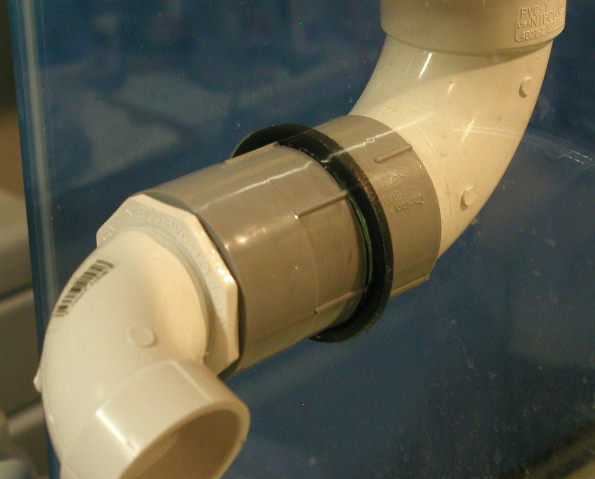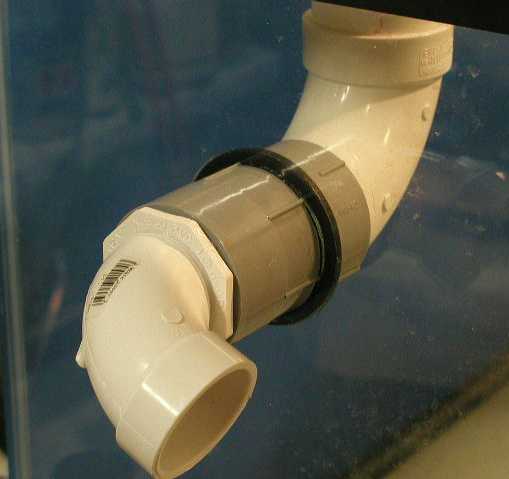

|
|
|
#1
|
|||
|
|||
|
$1.00 PVC Bulkhead
I was recently given a 29 gallon tank that had a hole cut in the side panel for a 2-inch bulkhead. The tank had formerly been used as a frag tank.
I needed a bulkhead to plug the hole, and I couldn't find one locally. I also didn't want to pay shipping for a single item, so I looked around to see what sort of DIY options were available. This thread is about how I built a DIY two-inch bulkhead for $1.40.  I had originally thought about using male and female PVC pipe connectors. PVC pipe connectors won't work because they have NPT threads. The National Pipe Thread standard provides for a tapered thread in order to facilitate sealing. Unfortunately, the tapered thread limits how far together a pair of male/female threaded connectors may be threaded. Normally the threads will "bottom out" before the adapters are close enough to butt up against the aquarium glass, and the result is a loose fit with gaps that isn't water tight. I took a walk down the electrical aisle at Menards and found threaded PVC connectors for electrical conduit. The electrical conduit adapters have non-tapered threads instead of NPT threads. This means that you can screw them all of the way onto one another until the two pieces abut one another. Add a rubber gasket and some silicone grease and you've got an inexpensive DIY bulkhead adapter. More to follow...
__________________
No honey, I swear that coral has been in there for months! Search via Google: "site:reefcentral.com keyword1 keyword2" Last edited by pescadero; 12/31/2007 at 08:34 PM. |
|
#2
|
|||
|
|||
|
The following photo shows a pair of male and female PVC adapters for electrical conduit. The large one is the 2-inch size. The smaller one is the 1-inch size.

__________________
No honey, I swear that coral has been in there for months! Search via Google: "site:reefcentral.com keyword1 keyword2" |
|
#3
|
|||
|
|||
|
The 1-inch male and female adapters cost $0.30 each. This allowed me to make a 1-inch bulkhead for about $0.60 plus the cost of a gasket. The 1-inch gaskets are commonly found in the plumbing aisle.
The 2-inch male and female adapters cost $0.70 each. This allowed me to make a 2-inch bulkhead for $1.40 plus the cost of a gasket. the two inch gaskets are commonly used for toilet valves and cost $1.50. I used an old one that I had found in a junk drawer. 
__________________
No honey, I swear that coral has been in there for months! Search via Google: "site:reefcentral.com keyword1 keyword2" |
|
#4
|
|||
|
|||
|
To build the bulkheads you'll also need some silicone tape and/or silicone grease, and a properly sized rubber gasket. If all else fails, you can buy sheets of rubber in the plumbing aisle and cut out your own gaskets.

__________________
No honey, I swear that coral has been in there for months! Search via Google: "site:reefcentral.com keyword1 keyword2" |
|
#5
|
|||
|
|||
|
Another view of the finished product:
 This is the finished bulkhead that has been fashioned out of male and femal 2-inch PVC electrical conduit adapters. A rubber washer was coated in silicone grease and slipped over the male adapter, which was positioned on the inside of the tank. The female adapter was screwed on from the outside. A 2-inch 90-degree street elbow has been slipped into the male adapter on the inside of the tank. A 1.5-inch 90-degree street elbow and a 1.5-inch to 2-inch reduction bushing have been slipped into the female adapter on the outside of the tank. thanks to RandallB for the tank!!!
__________________
No honey, I swear that coral has been in there for months! Search via Google: "site:reefcentral.com keyword1 keyword2" Last edited by pescadero; 12/31/2007 at 08:39 PM. |
|
#6
|
|||
|
|||
|
very nice
__________________
Click my red house to see my 125 build thread Want an RC search that works? Go here- http://www.reefcentral.com/search.php?s=&menu=11 |
|
#7
|
|||
|
|||
|
That's awesome! Thanks for sharing.
__________________
"Signatures are only good for 2 things....advertising and posting stupid quotes." - MrSandman |
|
#8
|
|||
|
|||
|
I would be very careful, thats not much of a sealing surface. Look at the width of the flange on a regular bulkhead, its probably 1/4 to 3/8" or more depending on the size of the bulkhead.
|
|
#9
|
|||
|
|||
|
i already noticed that. the width of the flange on a regular bulkhead is much wider. it would certainly help to have a wider flange than the flange that comes on a standard PVC fitting.
i'm not sure if you can see it in the photo, but the rubber toilet washer is about 3/8-inch thick, and L-shaped when viewed on cross-section. it is very rigid and very tight fitting. its very tough to get it to slip over the threads and once its there it stays there. it has a 3/8-inch flange built into it, which happens to be a VERY tight fit on the hole in the tank. with the combination of silicone grease and the rubber flange, it makes a very tight watertight seal with a lot of surface area. the difference in this bulkhead design is that the flange is provided by the stiff rubber washer rather than by the PVC. i've been using the tank as the top half of a 2 part sump for the past few weeks while i've been cooking rock. i've had no problems so far. i tore it down today and took the photos. there's no question that a heavy PVC flange is desirable. if you're going to put a lot of weight on the bulkhead, it would also help to distribute the weight of the PVC over more surface area on the glass. the rubber flanged toilet washer does that for you.  eventually i might cut a ring of out 3-inch PVC pipe or PVC sheet and use some weld-on to improve the $1 adapter so that it has a wider PVC flange. in the interim, i think that the basic design is valid, though it could be improved. much of the strength of the design comes from the rigidness of the L-shaped flanged washer and the tightness of it fitting on the PVC and on the hole in the aquarium.
__________________
No honey, I swear that coral has been in there for months! Search via Google: "site:reefcentral.com keyword1 keyword2" Last edited by pescadero; 12/31/2007 at 10:55 PM. |
|
#10
|
|||
|
|||
|
That is really nice thank you for sharing this. It would be nice like you stated for a short time or a low pressure system use.
__________________
Why BUY when you can DIY |
|
#11
|
|||
|
|||
|
I did the same thing with 3/4" on a 5g hex nano I used to have setup. It worked fine for a year before I lost interest in the tank due to the acrylic being too hard to keep clean without scratching and took it down.
|
|
|